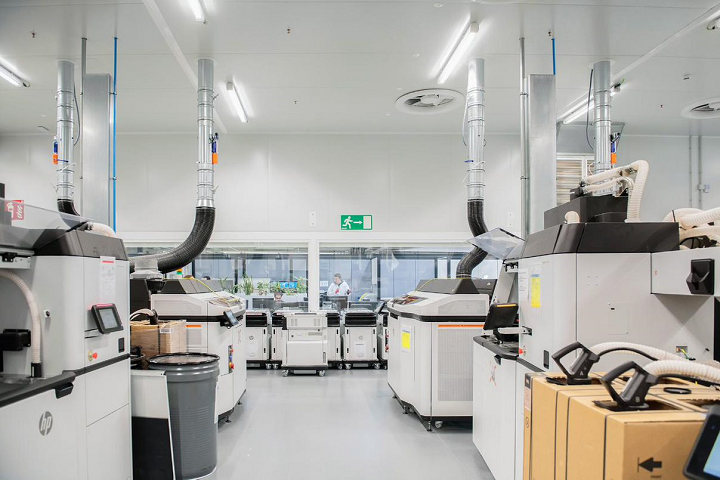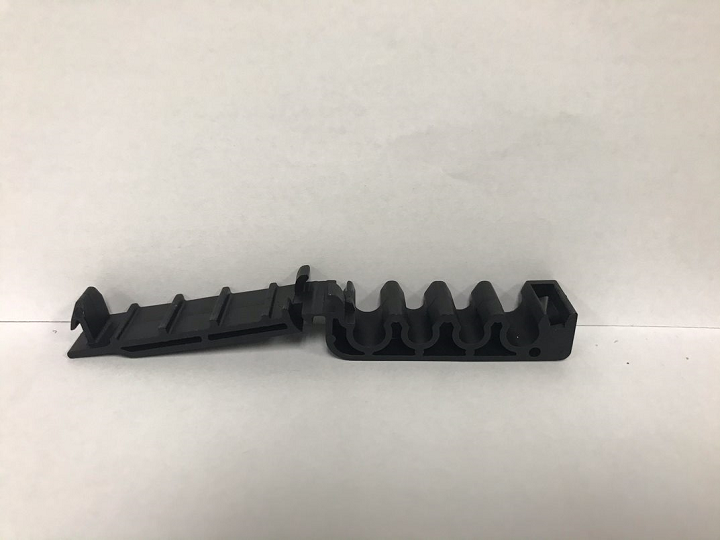In some of the most interesting additive manufacturing news I’ve heard recently, HP and Ford announced that they have teamed up to revolutionize how 3D printing waste is reused in the automotive industry. Both companies claim sustainability to be a major priority, and in a win for the circular economy, they have launched an industry-first program that takes used 3D printed powders and parts and turns them into injection molded vehicle components, specifically fuel-line clips that will first be installed on Ford’s Super Duty F-250 trucks. According to a press release, not only are the injection molded components better for the environment, but they also maintain the same level of quality and durability to which Ford customers are accustomed.
HP is a firm believer that additive manufacturing adds value to the continued growth of manufacturing systems and processes, and Ford, which has a company goal to achieve 100% sustainable materials in all of its vehicles, says that the technology could transform the customization of low-volume components for automobiles.
Debbie Mielewski, Ford technical fellow, Sustainability, said, “Finding new ways to work with sustainable materials, reducing waste and leading the development of the circular economy are passions at Ford. Many companies are finding great uses for 3D printing technologies, but, together with HP, we’re the first to find a high-value application for waste powder that likely would have gone to landfill, transforming it into functional and durable auto parts.”
According to the release, the injection molded fuel-line clips cost 10% less to make, are 7% more lightweight, and also have better moisture and chemical resistance than those made with traditional manufacturing processes. On top of the fact that the two companies figured out a handy way to increase the lifespan of used 3D printed powders, Ford’s research team has found that ten other fuel-line clips on the automaker’s existing vehicles would have value added by this innovative solution, and are working to implement them in future car models as well.
Ford has been recognized in the past for its use of 3D printing, and hasn’t stopped on that front: it’s always working to create new applications for the technology. It uses many different materials, such as sand, powder, and filament, and AM processes to manufacture multiple low-volume commercial vehicle parts, in addition to fixtures that are used by assembly line workers.
“A key to achieving our sustainability goals and solving the broader problems of society is working with other like-minded companies – we can’t do it alone. With HP, we defined the waste problem, solved technical challenges and found a solution in less than one year, which is something in which we all take pride,” Mielewski stated.
For its part, HP recently teamed up with another company to 3D print car parts for Nissan’s NISMO division. Its printers were designed with efficiency and sustainability from the get-go, both decreasing excess generated material and reusing more materials. Ford already uses HP’s Multi Jet Fusion (MJF) 3D printers at its Advanced Manufacturing Center, and together, the two developed and implemented this closed-loop, zero waste injection molding solution in less than one year.
“You get more sustainable manufacturing processes with 3D, but we are always striving to do more, driving our industry forward to find new ways to reduce, reuse and recycle powders and parts. Our collaboration with Ford extends the environmental benefits of 3D printing even further, showcasing how we are bringing entirely different industries together to make better use of spent manufacturing materials, enabling a new circular economy,” stated Ellen Jackowski, chief sustainability and social impact officer, HP.
Ford and HP worked with three other businesses to develop this unique, sustainable solution, and the first was oral care company SmileDirectClub, which operates this country’s largest amount of HP 3D printers: more than 60 MJF systems are used at its facility to help create over 40,000 dental aligners per day. To increase part volume for Ford in this new initiative, the 3D printed parts used to make the aligner molds are then collected and recycled with HP.
The other two partners are resin producer Lavergne, which has been a recycling partner of HP’s for a long time, and Ford supplier ARaymond, which designs, engineers, and manufactures assembly systems. In this instance, Lavergne takes the molds and used powder from Ford’s HP 3D printers and transforms them into recycled plastic pellets for injection molding. Then, ARaymond molds these pellets into the fuel-line clips for Ford’s vehicles.
According to the recently published SmarTech Analysis report “Additive Manufacturing in the Factory of the Future: Opportunities and Markets,” 3D printing “represents about one percent of the overall manufacturing and production landscape,” with obstacles to adoption including but not limited to high costs to scaling and difficulty in controlling quality across the supply chain. While this partnership isn’t directly related to 3D printing automotive parts, but rather recycling the powder and components to make different useful items, it’s definitely an example of a way to lower costs. The report also states that “AM will lead to lower fixed costs and smaller manufacturing footprints than traditional manufacturing,” and I think those will both be results of this unique initiative between HP and Ford. Well done.
(Source/Images: Ford)
Subscribe to Our Email Newsletter
Stay up-to-date on all the latest news from the 3D printing industry and receive information and offers from third party vendors.
You May Also Like
Gorilla Sports GE’s First 3D Printed Titanium Cast
How do you help a gorilla with a broken arm? Sounds like the start of a bad joke a zookeeper might tell, but it’s an actual dilemma recently faced by...
Nylon 3D Printed Parts Made More Functional with Coatings & Colors
Parts 3D printed from polyamide (PA, Nylon) 12 using powder bed fusion (PBF) are a mainstay in the additive manufacturing (AM) industry. While post-finishing processes have improved the porosity of...
$25M to Back Sintavia’s Largest Expansion of Metal 3D Printing Capacity Since 2019
Sintavia, the digital manufacturing company specializing in mission-critical parts for strategic sectors, announced a $25 million investment to increase its production capacity, the largest expansion to its operations since 2019....
Velo3D Initiates Public Offering in a Bid to Strengthen Financial Foundations and Drive Future Growth
Velo3D (NYSE: VLD) has been among a number of publicly traded 3D printing firms that have attempted to weather the current macroeconomic climate. After posting a challenging financial report for 2023,...




































